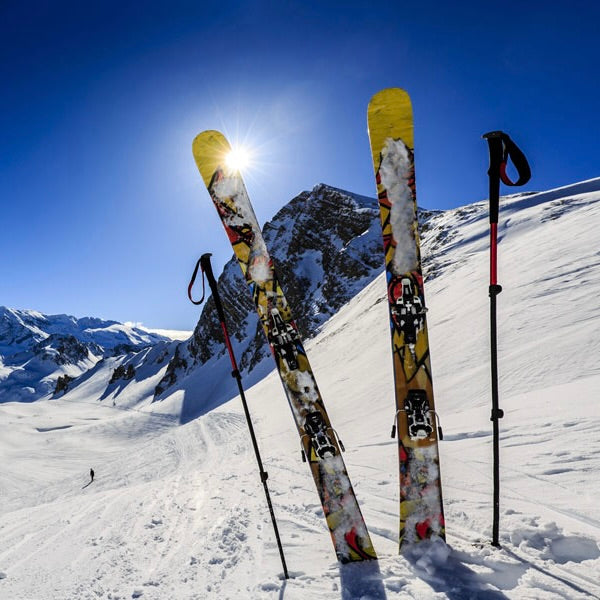The purchase choice regarding skis represents a very important moment and requires due consideration, to avoid ending up with inadequate, unmanageable or unsafe models. When choosing skis, it is essential to consider your skiing level, the area of use, your specialty and your physical characteristics.
In our shop we have selected and put on sale the best online ski models that combine high quality materials and safety, meeting the needs of every type of skier, from beginners to experts , who have already reached a high technical level and need equipment highly performing.
This ski buying guide is designed to offer useful information to help you easily identify the right ski model that is right for you in alpine skiing. To make this choice guide useful also for those who are approaching alpine skiing for the first time and who may not be familiar with how a ski is made, what its main parts are and the most important technical characteristics to take into consideration, we decided to divide it into two specific macro sections, each with related insights.
The first part of this guide aims to explain in detail how a pair of skis is made and will be divided into the following paragraphs:
If, however, you already have this basic knowledge, necessary for the choice, you can skip directly to the second part of this article which constitutes the actual guide to buying skis . Once the technical structural analysis of a ski has been completed, in the second part we will in fact analyze, point by point, what are the main elements to take into consideration to identify the right ski model and size for us. To identify the most suitable pair of skis, whether it is the first purchase or a new model, the search must be based mainly on the following parameters:
- Technical level of the skier
- Type of use
- Physical characteristics of the skier
- Personal skiing preference
How a ski is made: its main parts
Before delving into the actual choice guide, it is necessary to know what the fundamental parts of a ski are and its main characteristics and to have some technical knowledge related to their construction. Below we see the description of the individual components.

- Spatula or 'nose' : represents the raised front part of a ski;
- Skate : it is the central part of the ski, i.e. the one placed under the bindings;
- Tail : it is the back part.

As for the structure, they note:
- Edge : it is the metal part located on the edges of the ski base that must be sharpened regularly to maintain grip on snow;
- Insole : it is the lower part in contact with the snow, which allows slipping and may have grooves to facilitate water diversion. The insole is also waxed, i.e. rubbed with paraffin to obtain greater slip;
- Soul : it is the central part or the structure of the ski.
Construction technologies
Today's methods of building a ski, without prejudice to the hybrid ones, are:
- Sandwich which is used for racing or high-end skis;
- Monocoque generally used for medium or low level skis.

The sandwich construction is the most performing and expensive, it ensures axial and torsional rigidity , guaranteeing excellent stability and maximum control even at high speed. Otherwise, the monocoque construction arises from the need to create skis that are easy to maneuver but still able to offer good torsional stability.
Main materials used in the construction of skis
In recent years, ski production has evolved to the point of using innovative materials. Polymeric materials are widely used due to their ease of forming and processing and their not excessive cost. Materials used in ski manufacturing also include aluminum , titanium , glass fibers , carbon fibers , and graphene .
Sidecut and radius of curvature
Knowledge of some basic notions about ski geometry will also help in the choice. In the dynamic behavior of the ski, in addition to the relationship between flexion and torsion, the sidecut is fundamental. Let us try to explain the meaning of this term. The sidecut is the arc-shaped shape of the ski and is determined by three data in succession, namely the measurements of the spatula (which as we have already explained is the tip of the skis), skate (central part) and tail . These 3 measurements generate two arcs converging towards the center, then widening towards the tip and tail. The relationship between these measurements or rather their difference determines the static curvature radius of the skis .

However, it must be considered that during use the skis are subjected to various stresses which alter their original geometry. Bending , torsion and longitudinal deformations affect the static curve value, determining a new curvature value, i.e. the dynamic curvature radius .
Each ski has its own dynamic curvature radius. In other words, each ski closes the curvature arc following the motor action transmitted by the skier through the ski boots .
Consequently, the more deformable models easily close the curve arc at low speeds, facilitating the skier's motor gesture. On the other hand, the more easily deformable skis present less stability and less control as the load and speed increase and are aimed at beginners , as they are very manoeuvrable.
On the other hand, models with greater flexural rigidity have greater penetration into the snow, close the turn angle easily and are skis suitable for expert skiers who know how to exercise their motor action correctly.
When you make the turn on the edge of the ski, without skidding, you make a turn while leaving the mark on the snow of two perfect tracks. The radius of the skis is precisely that corresponding to the curve in conduction. An expert skier will know how to turn with a different radius than that of his ski, because he will know how to skid when necessary and how much is needed to create a radius different from that which the skis he is wearing would naturally draw.
A short radius, 11 to 14 meters , like that found in race slalom skis , allows for tighter, faster turns. A radius of 14 to 19 meters , present in giant race skis , it allows you to conduct wider turns. On freeride ski models, static curvature radii of up to 30 meters are achieved.
In ski models for beginners, the size of the radius is less relevant since, not yet knowing how to ski on the edge or trace curves while riding, beginners tend to go down snowploughs.
The following table provides some indications regarding the relationship between curve width and ski class.
| Ski class | Static bend radius |
|---|---|
| Race SLALOM | 11 - 14 m. |
| Race GIANT | 14 -19 m. |
| All Mountain / Park & pipe | 17 - 22 m. |
| Freeriding | up to 30 m. |
Bindings and plates
Most manufacturing companies today integrate bindings and plates into the ski, thus providing a complete set. The bindings are the mechanical parts which, when appropriately calibrated, perform the function of binding the skier to the ski, ensuring momentum and maximum safety against possible releases in every riding phase. The bindings have calibration mechanisms to adjust the springs they are equipped with.
The plates are real shock absorbers: they perform the function of absorbing vibrations, increasing stability, grip and precision, especially when cornering or on uneven terrain.
Competitive skis must comply with rigorous standards imposed by the FIS ( Italian Ski Federation ) regarding the overall thickness of the ski, plate and binding.
Nowadays the market offers many models suitable to satisfy every request and to this end, even the bindings and plates can be divided into: race , allround and easy .
Ski buying guide
Now that we know well how a ski is made and we have explored its main characteristics, it is possible to move on to the actual purchasing guide and analyze point by point all the parameters to be taken into consideration for the choice.
1. How to choose skis based on experience level
Even if the evolution of ski construction technology has made an ever-increasing range of models accessible to beginners, the technical level acquired by a skier is very important in order to identify the most suitable tool. To divide skiers based on skill level we will stick to the classification provided by FISI and the Italian Ski School:
-
Beginner and evolving skiers - Bronze level :
these are enthusiasts who have recently approached the sport of alpine skiing and have not yet acquired much confidence, they still slide their skis but aim to progress and improve, they begin to gradually reduce the snowplow opening, to look for the angle and to experience the first sensations of conducting. Bronze level skiers need skis with a soft, fault-tolerant flex that make it easier to change direction and allow you to focus on technique. Skiers at this level will be able to choose easy , all-round and all-mountain sport performance ski models of limited length . On this range of skis, a bridge with rocker in the tip and tail is generally adopted which helps to make the ski less wobbly and more manageable.
-
Intermediate skiers - Silver level :
This category includes skiers who have already acquired good confidence on slopes of varying difficulty, begin to draw curves of different arcs and tend to improve technique and speed. Silver level skiers need skis that provide stability , grip and precision . They should prefer all-round and all-mountain sport performance or high performance skis , while avoiding focusing on overly demanding models.
-
Expert skiers - Gold level :
they are skiers who have acquired an excellent technical level and complete control of their skis and have the ability to tackle all types of snow and slopes of all difficulty - they will choose top level all-round and high performance all-mountain skis;
-
Competitive skiers :
these are skiers who have reached high technical levels and intend to perfect their performance to give their best in competitions - they will focus on race ski models and FIS race skis;
2. How to choose skis based on the physical characteristics of the skier
A determining factor in the choice of skis concerns the morphology of the skier and first of all the gender. In fact, women's skis deserve a special mention as they are light, soft and easier to manoeuvre. Women have a lower center of gravity and less body mass than men. Furthermore, women exert less force when driving than men. Women's skis are built with fewer laminate layers and have a more forward position of the bindings than that found on men's skis, precisely to adapt to the female physique. Lightness and softness are also prerogatives of junior skis, which range from basic versions to race ones.
3. How to choose the length of the skis
The height and weight of the skier are variables to keep in mind during the purchase choice, although in conjunction with what has already been described and without absolute definitive rules being able to be drawn from them. The system generally adopted to determine the ideal ski length consists of considering the distance between less than and a few centimeters above the head. The following table will help you choose:

As already mentioned, the measures represent references that can however be derogated from. Often, in fact, professional skiers, accustomed to high speed or involved in giant slalom, choose skis that are much longer than their height.

